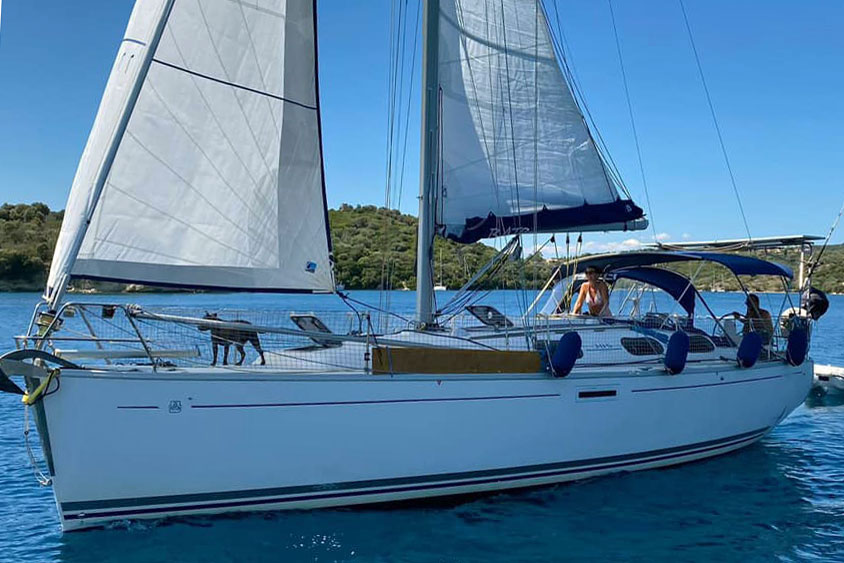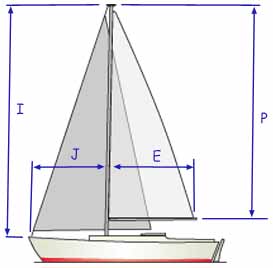- Home
- Cruising Yachts 35' to 40'
- Dufour 385 Grand Large Sailboat Specs
The Dufour 385 Grand Large Sailboat
Specs & Key Performance Indicators
The Dufour 385 Grand Large, a fractional cruising sloop designed by Italian naval architect Umberto Felci in collaboration with Patrick Roséo, was built by Dufour Yachts in La Rochelle, France.
 'Bato', a Dufour 385 Grand Large
'Bato', a Dufour 385 Grand LargePublished Specification for the Dufour 385 Grand Large
Keel & Rudder Configuration: Fin keel with bulb and spade rudder
Hull Material: Fiberglass
Length Overall: 11.7 meters (38.45 feet)
Waterline Length: 9.4 meters (30.91 feet)
Beam: 3.9 meters (12.89 feet)
Draft: 1.8 meters (5.77 feet)
Rig Type: Fractional Sloop
Displacement: 6,980 kilograms (15,388 pounds)
Ballast: 1,950 kilograms (4,299 pounds)
Water Tank Capacity: 439 liters (116 gallons)
Fuel Tank Capacity: 159 liters (42 gallons)
Hull Speed: 7.45 knots
Designer: Umberto Felci and Patrick Roséo
Builder: Dufour Yachts
Year First Built: 2005
Year Last Built: Ongoing
Sail Areas & Rig Dimensions
- Mainsail Area: 27.2m2 (292.67ft2)
- Foresail Area: 30.8m2 (331ft2)
- Total Sail Area: 58m2 (624ft2)
I: 14.0m (46'0")
J: 4.4m (14'5")
P: 12.8m (42'0")
E: 4.3m (14'0")
Published Design Ratios
The Key Performance Indicators (KPIs)
- Sail Area to Displacement Ratio (SA/D): 16.2
- Ballast to Displacement Ratio (B/D): 27.94%
- Displacement to Length Ratio (D/L): 232.61
- Comfort Ratio: 23.82
- Capsize Screening Formula (CSF): 2.08
The following analysis of the primary design ratios gives an indication of the boat's likely sailing characteristics, but see the 'Notes of Caution' that follow below:
- Sail Area to Displacement Ratio (SA/D): At 16.2, this ratio indicates that the Dufour 385 Grand Large has reasonably good performance. It is not underpowered and should perform well under sail, providing a balance between power and weight.
- Ballast to Displacement Ratio (B/D): With a ratio of 27.94%, the boat has moderate stiffness. While it is not as stiff as boats with a B/D ratio of 40 or more, it should still handle wind reasonably well, offering a good balance between stability and performance.
- Displacement to Length Ratio (D/L): The ratio of 232.61 places the Dufour 385 Grand Large in the moderate displacement category. This means it requires a moderate amount of sail area to reach its design hull speed, balancing between light and heavy displacement characteristics.
- Comfort Ratio: At 23.82, this ratio suggests that the boat has a somewhat lively motion, typical of a coastal cruiser with moderate stability. It should provide a comfortable ride in coastal waters, though it may feel more lively in rougher conditions compared to heavier bluewater cruisers.
- Capsize Screening Formula (CSF): With a CSF of 2.08, the Dufour 385 Grand Large is slightly above the threshold of 2.0, indicating it is more suited for coastal cruising rather than extended ocean passages. The higher the CSF, the more susceptible the boat is to capsizing in extreme conditions.
These ratios collectively suggest that the Dufour 385 Grand Large is a well-balanced coastal cruiser with good performance, moderate stability, and comfort suitable for coastal and nearshore sailing.
Design Ratios: Notes of Caution...
- The Sail Area/Displacement Ratio (SA/D): This ratio provides an estimate of the sail power relative to the boat's weight, which can indicate potential speed in various wind conditions. But it doesn't account for the efficiency of the sail plan, the rigging, or the skill of the crew. Real-world performance can vary significantly based on these factors.
- The Ballast/Displacement Ratio (B/D): This ratio gives an idea of the boat's stability and stiffness, which is crucial for handling and safety. But it doesn't consider the distribution of the ballast or the hull shape, both of which can greatly affect stability. A high B/D ratio alone doesn't guarantee a stable boat if the ballast is poorly distributed.
- The Displacement/Length Ratio (D/L): This ratio helps predict the boat's speed potential and its behaviour in different sea conditions. But it doesn't account for the hull design or the boat's overall weight distribution. Two boats with the same D/L ratio can perform very differently if their hull shapes are different.
- The Comfort Ratio (CR): This ratio estimates the boat's motion comfort in a seaway, which is important for long passages. But it doesn't consider the boat's interior layout, which can also affect comfort. Additionally, personal tolerance to motion varies, so a boat that is comfortable for one person might not be for another.
- The Capsize Screening Formula (CSF): This formula assesses the likelihood of a boat capsizing in heavy seas, which is critical for offshore safety. But it doesn't take into account the boat's handling characteristics or the skill of the crew. A boat with a low CSF can still capsize if poorly handled in severe conditions.
General Limitations
- Static Nature: These ratios are static measurements and don't account for dynamic factors like wave action, wind gusts, or crew actions.
- Simplification: They simplify complex interactions into single numbers, which can be misleading. Real-world performance is influenced by a multitude of factors that these ratios can't fully capture.
- Context: The context in which the boat is used (e.g., coastal cruising vs. offshore racing) can greatly affect how these ratios should be interpreted.
In summary, while these ratios provide valuable insights into the theoretical performance characteristics of a sailboat, they should be used as part of a broader assessment that includes practical experience, sea trials, and expert advice.
This article was written with the assistance of Gemini, a large language model developed by Google. Gemini was used to gather information, summarize research findings, and provide suggestions for the content and structure of the article.
Recent Articles
-
Albin Ballad Sailboat: Specs, Design, & Sailing Characteristics
Jul 09, 25 05:03 PM
Explore the Albin Ballad 30: detailed specs, design, sailing characteristics, and why this Swedish classic is a popular cruiser-racer. -
The Hinckley 48 Sailboat
Jul 09, 25 02:44 PM
Sailing characteristics & performance predictions, pics, specifications, dimensions and those all-important design ratios for the Hinckley 48 sailboat... -
The Hinckley Souwester 42 Sailboat
Jul 09, 25 02:05 PM
Sailing characteristics and performance predictions, pics, specifications, dimensions and those all-important design ratios for the Hinckley Souwester 42 sailboat...













